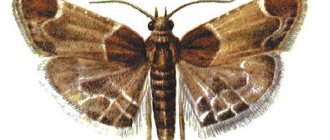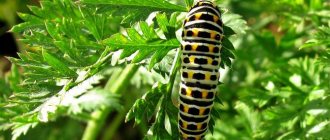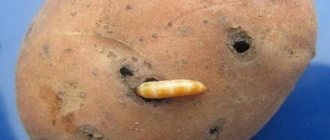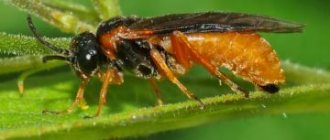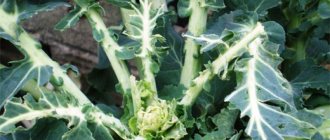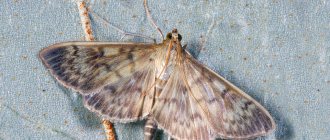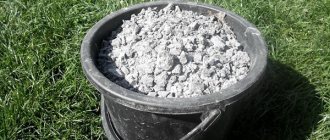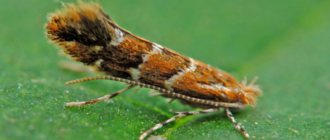What parasites attack these flowers?
Reference. Most often, pests look like small bugs, mostly white in color.
Their concentration is large, therefore, it is difficult not to notice them. Most often, an orchid is attacked by:
- aphid;
- spider mite;
- thrips;
- worm.
As a result of their influence, affected areas are formed on leaves, stems and flowers, which are characterized by a brown color, dry to the touch, and sometimes even ruptures in the plant tissue occur.
Types of pests
Orchids are rather capricious flowers. Therefore, they are not only prone to damage by pathogenic microflora, but are also often attacked by all kinds of parasites. Below we will discuss the most common harmful insects for these flowers.
Scale insects and false scale insects
The presence of these pests is indicated by the appearance of brown or yellow growths on the plant. An adult is hidden in such growths. The larvae can move around the flower, feeding on plant sap.
Mealybugs and rootbugs
Both varieties of mealybugs feed on plant sap. If parasites are not detected in time, then they can lead to the death of the orchid. Pests are small in size. They live in the roots, at the base, under the scales, under the covering leaves, as well as under fallen leaves and dry plates.
The mealybug is covered with a white coating, which is its characteristic feature. Colonies of these parasites look like cotton wool or cobwebs. The root bug prefers to settle, as you might guess, in the root system. The pest has a pale pink, gray or yellow body color. Both parasites, feeding on plant sap, can cause the death of an orchid.
Whitefly
This is a small butterfly that lays its eggs under the bark or on the lower surface of the leaf blade. After hatching, the larvae begin to eat the leaves of the flower. This parasite is difficult to get rid of, as the butterfly can fly to another plant.
It is worth noting that feeding and treating the orchid with certain means (especially organic ones) provoke the proliferation of whiteflies, making the fight against it even more difficult.
Ticks
This type of parasite is tiny in size, which prevents early detection of an insect in a flower pot. Some varieties can only be seen with a magnifying glass. The most common types of mites found in an orchid pot are:
- root. This species penetrates the roots and feeds on the sap. As a result, the roots turn into hollow formations that can no longer perform their function;
- bulbous. Affects the base of leaves;
- flat mite. The smallest representative of its species;
- red spider mite. The most dangerous parasite. The main symptom of infection here is the appearance of a white coating on the leaves. Yellow spots develop at the bottom of the leaf blade.
If these pests are identified, you must immediately begin treatment of the flower.
Woodlice
These are soil parasites. Insects eat everything they see on their way: shoots, leaves, etc. Their appearance is signaled by small holes.
The main danger of aphids is that they serve as a carrier of various diseases. The pest feeds on the sap of leaves. At the site of the bite, deformed plant tissue remains, which is covered with a sticky coating. A sooty fungus develops on this substance.
Poduras or springtails
Podurs are small brown or grayish parasites that live in the soil. These are the most harmless pests that can be found in a flower pot. This is due to the fact that insects feed on substances that are in the ground. But if they are deficient, they can switch to young roots.
Nematodes
These are millimeter worms that are barely visible without a magnifying glass. An orchid with prolonged parasitism of nematodes becomes poisoned, which is caused by the waste products of the pest. Over time, the flower becomes covered with a coating of rot and dies.
Thrips
Thrips are another tiny insect. Their body length is only a couple of millimeters. Outwardly, they resemble “sticks” with black or brown wings. The parasite moves quite quickly. In a pot it lives in the substrate. When affected, black dots and a silver film appear on the orchid. Thrips come to the surface only at night.
What is the danger?
As a result of exposure to pests, plants stop growing, the process of providing moisture and nutrients slows down, and ultimately, the phalaenopsis dies.
At the initial stages of infection, the leaves begin to lose moisture and rapidly turn yellow, gradually curling.
If you run your hand over the surface of the leaf, you will find that it is completely covered with a slimy substance. Strange bumps, punctures, and damaged areas begin to appear on the stem, so it is likely that the stem may simply break off.
All of these phenomena indicate that plants are exposed to pests.
How to fight nematodes
These pests are very dangerous. Often the affected plant cannot be cured. As a result, it is simply burned. If the degree of damage is small, then you can try to control the pests. But it is best to take preventive measures. For these purposes, it is necessary to thoroughly wash the leaves of the plants approximately once every 5 days. In addition, it is worth rinsing the substrate itself under running water. This procedure can be carried out once a month.
To combat nematodes, you can use a solution of the drugs “Levamizal” or “Dekaris”. You need to dilute 1 tablet in a liter of water. In the prepared solution, you can soak the entire plant without substrate or spill the soil in which the orchid grows. The procedure must be repeated again after a few weeks.
It is worth noting that nematodes die at high temperatures. Therefore, you can bathe the plant in water whose temperature is 40°C. The procedure should be carried out within half an hour. At the same time, you should carefully monitor the condition of the orchid. When carrying out such treatment, the plant may die. With proper care, domestic orchids are very rarely affected by nematodes. Therefore, these pests are the last thing to be considered.
What parts of the plant are affected?
As we have already found out, insects begin to appear from the very roots; most likely, they initially choose a substrate for life. It is there that they multiply, grow stronger, and then rise upward.
Therefore, the root system of phalaenopsis is initially affected. Namely, thanks to the roots, the plant can feed and receive nutrients from fertilizer and liquid. Affected roots cannot absorb moisture in the required volume, so the plants begin to rapidly turn yellow.
Important! Insects begin to climb up the roots, after which leaves meet them on the way. Therefore, the leaves closest to the substrate are affected first.
They become yellow, lifeless, and have bite marks and dark spots.
Then the insects climb up the stem and go to the flowers. As a rule, this is the last stage of the development of the disease, followed by the death of the plant.
How to check a flower for harmful insects?
Unfortunately, many people neglect such a simple procedure, as a result of which they endanger not only the orchid, but also other flowers in their home.
The check is quite simple.
- To do this, you need to remove the plant from the plastic protective bag.
- The inspection begins with the roots, which are probably clearly visible through the plastic container. Make sure they are intact, without rotting or dried rhizomes.
- The substrate must be homogeneous, without traces of any insects.
- Pay attention to the leaves. They should be healthy, fleshy, bright or dark green in color, with no signs of lack of moisture.
- Gently run your hand along the stem. It should be smooth, without thinning, as well as strange bumps in its structure.
- Flowers should be bright, elastic, tightly fitting.
Attention! After the visual inspection is completed, thoroughly water the orchid. If there really are insects, then perhaps they will flow out of the drainage system of the pot along with the water. Pests can be easily seen in clear liquid.
Thrips
Thrips are sucking pests of orchids and other indoor crops. Their size does not exceed 2 mm, so it is difficult to notice them on flowers. Thrips damage not only the above-ground part of the orchid, but also its roots. Their presence can be guessed by small pinpoint damage on the back of the leaves. Thrips can also hide in the substrate, where they feed on juices from the roots of the plant.
Control measures and prevention
Getting rid of thrips is quite difficult. Adults of this pest easily fly from one plant to another. Therefore, if thrips appear on an orchid, action must be taken immediately. The first thing to do is isolate the infected plant from the rest.
Then the quarantined orchid is thoroughly washed under running warm water. This will not completely destroy the pest, but it will significantly reduce its population. After a shower, all damaged tissue is cut out from the leaves of the plant. Only after all the above procedures are insecticides used.
You can treat an orchid against thrips using Actellik or Commander. Drugs should be diluted in strict accordance with the instructions. After 10 days, repeated treatment is carried out. Preventing the appearance of thrips involves systematically inspecting the inner surface of leaf blades and following the rules of care.
Thrips
Types of insects with photos and control measures
Ticks
The spider mite is the driver most often found on phalaenopsis. It has a yellow color, less often red. Quickly lays larvae.
- To combat it, it is necessary to remove the affected leaves.
- Parts of the plant that remain above the ground must be wiped with a sponge soaked in Fitoverm solution.
Thrips
Thrips most often have a black tint, less often they are found in yellow and red. There are more than 8 species of these pests.
- In order to remove strips, it is necessary to give the orchid a generous shower in a timely manner.
- Purchase Vertimek and treat the plants with it, following the instructions.
Attention! Do preventive maintenance; for this you need to make a mixture of water and olive oil, and thoroughly wipe the leaves.
Whitefly
Whiteflies most often attack leaves and flowers. Therefore, to get rid of it, it is enough just to remove the affected leaves, as well as peduncles.
Reference. Do not forget to constantly spray the plants with tobacco infusion. In extreme cases, chemicals are used.
Sucking parasites
To combat such a scourge, it is necessary to use Permethrin or Fitoverm. You can also install special traps with Insecticide, which will give a good effect.
Don't forget to spray with soapy water.
Aphid
Aphids cannot tolerate laundry soap. People who tend their own gardens and protect their plants from pests know this very well.
Important! A soap solution with laundry soap or tar soap will be enough to get rid of aphids.
Nematodes
Nematodes look like light and transparent worms that reach a length of 2 mm. It's quite easy to see them. They affect the root system and stems.
You can fight such a scourge with the help of Dekaris. To do this, one tablet of the drug is diluted in one liter of water, after which the soil is watered and the plants are sprayed. Also, nematodes simply cannot tolerate high temperatures. Therefore, the flower can be given a shower with forty-degree water.
Woodlice
Woodlice often attack orchids, especially if they are in a damp room. It can reach up to 1 cm in length and has a marbled shell.
Attention! To fight, you can use fairly simple folk recipes that act on wood lice accordingly. A solution of laundry soap is ideal, with which you need to periodically spray the orchid until the insects are completely destroyed.
Mealybug
The insects have a light brown or pink body, and reach a length of no more than 5 mm. Visually detecting them is not so difficult. It looks like furry balls that move slowly.
To fight, you need to manually remove all the balls from the leaves and stems.
Scale insect and false scale insect
These pests reach 5 mm in length. They have a light or dark brown tint.
Reference. Males have wings.
Treatment of this parasite must begin with chemical treatment. The most effective is Actellik.
Types of parasites
Aloe diseases: causes of diseases and their treatment options
Phalaenopsis is a plant that has a lot of “sworn enemies”. The most common harmful insects are:
- Thrips;
- Spider mites;
- Mealybug;
- Shield.
Pests often appear due to high air humidity
If you take the plant outside, especially on a rainy and cloudy day, woodlice and caterpillars may crawl into the soil.
Mealybug
White insects on orchids are not uncommon. The mealybug is well known to domestic gardeners as the most common pest of Phalaenopsis. Popularly, this insect received the funny nickname “shaggy louse” for its great mobility and the white hair that covers the outside of the parasite’s body. The scale insect lives in the ground.
Adult insects do not feed; young insects suck the juice from the stems and leaves of Phalaenopsis. It is easy to recognize the “uninvited guest”: when a bug moves along the surface of a flower, it leaves behind a white mucous trail. If white bugs appear in the soil of an orchid, you need to take action immediately.
If small whitish insects are found, dry leaves should be removed and watering increased, because the scale insect does not like moisture.
Shchitovka
It is also recommended to regularly wipe Phalaenopsis leaves with a cloth soaked in warm water and spray.
Ticks
Mites are often parasites on orchids. There are many varieties of these parasites, the most common of which is the spider mite. It climbs deep into the ground, feeding on the roots of the plant, and also actively sucks juice from the leaves. The appearance of a mite is signaled by browned and dried leaves. The main insidiousness of this pest is that it is very difficult to detect, because the length of an adult tick is no more than 0.5 mm.
Typically, gardeners notice a mite infestation when a web appears on the orchid; this is the last stage of the disease. For control, it is recommended to use industrially produced insecticides. You should alternate between different types of drugs, because the tick quickly gets used to them and develops a strong immunity.
The mite sucks all the juices from the plant, depleting the orchid
It is quite difficult to notice a mite on an adult plant. If brown specks begin to appear on the leaves of the orchid, you should take a close look at them. Moving dots are tick colonies. In this case, you need to take immediate action, as this insect reproduces very quickly.
Treatment with any insecticide should be carried out several times, at intervals of 5-10 days. It must be borne in mind that chemicals do not affect insect eggs, so the most reliable way to combat mites is to transplant the plant into new soil and burn the old pest-infected soil. Some poisons intended to combat parasites can be very dangerous for children and pets.
Shchitovka
Scale insects are one of the most dangerous pests on orchids; because of it, plants, especially young ones, can completely die. This insect got its name because it is covered with a hard shell, like a shield or armor.
Adults and larvae feed on orchid stems, depriving the plant of nutrients and depleting it. Infestation by scale insects is indicated by yellowed leaves with a coating of sticky mucus on them.
The best way to control them at home is to collect pests by hand and then destroy them.
Important! This procedure must be carried out repeatedly. It is known that scale insects do not like the smell of tar soap, so a solution based on it can be used at home for spraying.
Other types of pests
In addition to mites, scale insects and scale insects, there are other pests of orchids. First of all, these are leaf aphids. Phalaenopsis is also often parasitized by:
- Thrips (small stick-shaped worms);
- Nematode;
Nematode - Whitefly butterflies;
- Slugs and snails.
The most reliable method of dealing with them is collecting and burning, as well as replacing the affected soil. When replanting Phalaenopsis, you should carefully inspect the ground for the presence of any insects. Larvae and eggs can hide in the lower layers of soil, closer to the roots, and gnaw them. Affected roots are carefully cut off and destroyed. Inspection of flowers should be carried out regularly so as not to miss the onset of a dangerous disease and to begin treatment on time.
What destruction methods cannot be used?
Many orchid owners make serious mistakes when wanting to rid their plants of pests.
For example, he begins to water the plants frequently and abundantly, thinking that this will increase his immunity and the orchids will get rid of pests on their own. In fact, the aquatic environment allows the pest to develop.
Another mistake is the use of aggressive chemicals. In this way, people try to quickly get rid of pests, but in fact, they destroy the plant.
Further care of the plant
There is no need to feed the plants at this stage. You can do this a month after you got rid of the pests and the plant has recovered a little.
It is necessary to purchase fertilizer specifically for phalaenopsis. Also, do not forget to create the necessary temperature and humidity around the flower.
Phalaenopsis is a very delicate and fragile plant. It may not be attacked by pests so often. However, if this happens, you need to act as quickly as possible in order to save your pet and in no case lose it. Care must be taken even at the doorstep of the store, since in 80% of cases, the flower is already infected and brought into the house.
Midges in orchids: how to get rid of them at home
Mealybug on an orchid: how to get rid of pests and treatments
If there are midges in an orchid, what to do first:
- Place the pot with the infected plant in quarantine for a month, that is, place it separately from other flowers.
- Place the flower under a gentle stream of warm water to wash away larvae, eggs and adults.
- Inspect the soil, stems and leaves, remove any remaining eggs and larvae with a damp cloth.
- Cut off dead and damaged parts of the plant, dust the cut areas with ash or crushed coal.
To remove pests from the roots, the plant is thoroughly washed with warm water.
Important! If the soil is heavily infested with pests, it is necessary to replant the orchid, thoroughly washing the roots.
Traditional methods
What to do if midges appear in the ground in orchids:
- Treat with soapy water. 1 tbsp. l. soap (preferably without dyes and other additives) is diluted in a glass of water. Moisten a cotton pad with the composition and gently wipe all parts of the plant for a week. After a break of several days, another 2-3 treatment cycles are repeated. When the insects disappear, wait a month, after which they wipe the flower once to prevent the reappearance of midges.
- Use garlic infusion. The cleaned head is crushed, poured Art. boiling water The liquid is used in the same way as a soap solution.
- Prepare an apple cider vinegar trap. The liquid is poured into a small jar, mixed with a couple of drops of dishwashing gel, and closed with a plastic lid with small holes made in it. The prepared container is placed next to the flower pot. Midges (fruit flies and sciarids), sensing the smell, will fly inside and die, since they will not be able to get out of the trap.
- Place citrus peels or garlic cloves around the plant. This folk method is based on the fact that strong odors repel insects.
- Prepare a weak solution of potassium permanganate and pour it over the soil. The disinfectant liquid will destroy the eggs and larvae.
- Sprinkle the soil with mustard powder. Repeat the procedure once a week until all midges disappear.
Spraying with garlic infusion is a plant-safe way to remove pests
Chemicals
Getting rid of insects using potent drugs is recommended in extreme cases when other methods have not helped.
The most difficult thing to deal with are sciarids. You will need to use several products in combination: the above-ground parts of the plant are treated with “Raid”, “Raptor” or “Neo Dichlorvos”, for the soil use “Bazudin” or “Grom-2”. Pests can remain not only in the pot, but also on the surfaces around it, so you need to wipe the windowsill with a disinfectant.
Actillicom is suitable for killing thrips. The infected plant is treated with this drug three times over a period of 10 days.
“Actellik” also effectively copes with whiteflies. They are also removed using insecticides “Sherpa” or “Fury”. To get rid of eggs and larvae, the soil is spilled with water.
How to get rid of it at home using biological methods
If midges appear in orchids, you can get rid of them using home remedies:
- Vacuum cleaner. It will help collect whiteflies. When you touch the phalaenopsis, the butterflies immediately fly up, disturbed. You can take advantage of this behavioral feature of theirs. You need to turn on the device in advance and point the end of the suction tube (it is better to remove the nozzle) just above the plant. Touch the orchid and the whiteflies will fly up and be sucked in. It will not be possible to collect all the midges at once; you need to repeat the operation several times, taking breaks.
- Fly tape. A ribbon hung near an infested plant will collect most of the adults.
- River sand. It is pre-calcined in the oven and then poured in a thin layer onto the ground. Monitor the condition of the plant: after a few days all the midges should disappear, and if this does not happen, the procedure is repeated.
- Soil washing. Since the most difficult thing is to remove not the adults, but the larvae, you need to thoroughly wash the soil every 4 days.
Note! If there are fruit flies in the house and flower pot, you need to fight them differently. You should throw away the remains of moss, tea leaves and other natural fertilizers, if they were used, and reduce the frequency of watering. Inspect the room, remove all food that attracts fruit flies (fruits, vegetables).
To get rid of fruit flies, all moss from the ground must be removed


